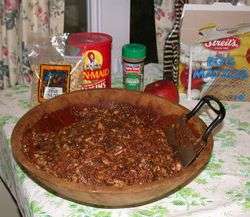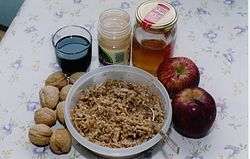Charoset
- For the ancient city in the Hebrew Bible, see Harosheth.


Charoset, haroset, or charoses (Hebrew: חֲרֽוֹסֶת [ḥărōset]) is a sweet, dark-colored paste made of fruits and nuts eaten at the Passover Seder. Its color and texture are meant to recall mortar (or mud used to make adobe bricks) which the Israelites used when they were enslaved in Ancient Egypt as mentioned in Tractate Pesahim (page 116a) of the Talmud. The word "charoset" comes from the Hebrew word cheres — חרס — "clay."
Charoset is one of the symbolic foods on the Passover Seder Plate. After reciting the blessings, and eating a matzah "Hillel sandwich" combining charoset and maror, the remainder is often eaten plain, spread on matzah.
History
Charoset is mentioned in the Mishna in connection with the items placed on the Passover table: "unleavened bread and lettuce and charoset." Some say it can be traced back to the custom of symposia in ancient Greece, where philosophical discussions were accompanied by drinking large quantities of wine and consuming foods dipped into mixtures of pounded nuts and spices.[1]
Variations
There are many recipes for charoset. Many include at least some of the fruits and spices mentioned in the Song of Songs: apples 2-3, figs 2-13, pomegranates 4-3, grapes 2-15, walnuts 6-11, dates 7-7 with the addition of wine 1-2, saffron 4-14 and cinnamon 4-14. [2]
Ashkenazi traditions
Eastern European (or Ashkenazi) charoset is made from chopped walnuts and apples, spiced with cinnamon and sweet red wine. Honey or sugar may be added as a sweetener and binder. The mixture is not cooked.
Sephardi traditions
Sephardi charoset is a paste made of raisins, figs and date.
Egyptian Jews make it from dates, raisins, walnuts, cinnamon, and sweet wine.
Greek and Turkish Jews use apples, dates, chopped almonds, and wine. Italian Jews add chestnuts.
Some Spanish and Portuguese communities such as the Jews of Suriname, add coconut.
Mizrahi traditions
Not all Jews use the term "charoset". Some of the Jews of the Middle East instead use the term "halegh". The origin of halegh is not clear. Rav Saadia Gaon uses the word and attributes it to a kind of walnut that was a mandatory ingredient in the preparation of the halegh.
Parts of the Jewish Diaspora in Iran have a tradition of including forty different ingredients in the halegh. The number forty signifies the forty years of wandering in the desert.
Modern variations
In 2015 Ben & Jerry's Charoset ice cream became widely available in Israel and was covered in several major news outlets.[3][4][5][6][7][8][9]
References
- ↑ The sweet story of Charoset
- ↑ Rabbi Arthur Waskow (2009-04-08). "Passover's R-Rated Condiment". The Washington Post.
- ↑ "Ben & Jerry's Haroset Flavored Ice Cream". The Times of Israel. Retrieved 2016-04-12.
- ↑ "Ben And Jerry's Sells Charoset-Flavored Ice Cream Just In Time For Passover". The Huffington Post. Retrieved 2016-04-12.
- ↑ "Forget Cherry Garcia. How about Ben and Jerry's Passover ice cream?". Public Radio International. Retrieved 2016-04-12.
- ↑ "Charoset Ben & Jerry's: Who's brave enough to try?". The Jerusalem Post | JPost.com. Retrieved 2016-04-12.
- ↑ JTA (2015-03-25). "Ben & Jerry's Charoset Flavor and 10 More Passover Ice Cream Ideas". Haaretz. Retrieved 2016-04-12.
- ↑ "http://www.bustle.com/articles/71377-charoset-flavored-ben-and-jerrys-ice-cream-exists-in-israel-and-yes-its-kosher-for-passover". www.bustle.com. Retrieved 2016-04-12. External link in
|title=(help) - ↑ "http://www.bustle.com/articles/71377-charoset-flavored-ben-and-jerrys-ice-cream-exists-in-israel-and-yes-its-kosher-for-passover". www.bustle.com. Retrieved 2016-04-12. External link in
|title=(help)